How Do Ocean Wind Turbines Affect Wildlife?
If a bird encounters a wind turbine at sea, will it fly around it?

Offshore wind farm. | Photo by Mike Mareen
In March last year, the Biden administration announced a plan to generate 30 gigawatts of offshore wind power by 2030, enough to provide electricity for more than 10 million homes. To meet that goal, the Departments of Interior (DOI), Energy (DOE), and Commerce (DOC) announced a plan to collaborate on expediting the leasing and permitting processes for offshore wind facilities. The first large-scale offshore wind facility in the US, the 800-megawatt Vineyard Wind farm, was approved a few months later and broke ground off the coast of Cape Cod, Massachusetts, in November.
Historically, many environmental groups have worked to slow down the permitting process for development until possible impacts to wildlife have been studied. Today, the environmental consequences of not speeding up offshore wind development are arguably worse than delaying it. In August 2021, the most recent report from the Intergovernmental Panel on Climate Change (IPCC) emphasized how urgent the stakes are: Unless countries around the world cut their carbon emissions drastically in the next few years, climate change will devastate ecosystems around the world within our lifetimes.
In the case of offshore wind, permitting and research are happening in parallel. In October, the DOE announced it would invest $13.5 million in environmental research, exploring how offshore wind farms affect birds, bats, fish, and sea mammals. Existing research shows that building and operating offshore turbines can affect birds, fish, and marine mammals in various ways—though it's not nearly as disruptive as an oil spill or the cumulative impacts of climate change accelerated by burning fossil fuels, experts say. And the proliferation of new offshore wind facilities will help advance the understanding of human impacts on marine wildlife as well.
The sound of turbines
One of the recipients of that new funding is the Wildlife and Offshore Wind (WOW) project at Duke University, which received $7.5 million from the DOE to help assess the risks of offshore wind to marine life. Douglas Nowacek, WOW’s director, has spent much of his career studying bioacoustics, in particular the ways that sounds made by humans affect organisms in the ocean. Constructing wind turbines in the sea requires hammering monopiles into the sea floor and makes a lot of noise: “It’s loud, no doubt about it,” Nowacek says. Organisms that typically frequent an area may avoid it during construction, or abandon it altogether, Nowacek says. For example: Migrating whales may opt to take a longer route around an offshore wind facility after it’s built.
WOW will spend the next year collecting data from existing studies and identifying information gaps and research questions. As new offshore facilities are developed, researchers will tag animals and see how they respond to construction noise. Even with the accelerated permit process, it will take years to build turbines in all the lease areas in the Atlantic, and Nowacek believes the population impacts on ocean mammals will be minimal. “At the scale we’re talking about on the east coast of the US right now,” says Nowacek, “they are highly manageable.”
For the birds
Wind farms built on land have had some high-profile conflicts with wildlife over the years, particularly birds. A wind farm built in the Altamont Pass in Alameda County, California, in the 1980s was blamed for killing thousands of raptors and other birds every year, and recently swapped out many of its turbines with newer models designed to decrease the likelihood of bird strikes. New technologies that help birds avoid turbines are also becoming more common. But there are still challenges to understanding how offshore wind will affect migratory birds, including the fact that a bird that’s killed offshore is much harder to count than one that dies on land.
Andrew Farnsworth, a senior research associate at the Cornell Lab of Ornithology, works to monitor migrating birds using weather radars, which are able to detect a flock of birds moving through an area. In any given migration season, Farnsworth says, some birds will fly over water while others fly over land. Migration offshore tends to be less dense than on land, but the prospect of offshore wind farms killing birds or otherwise interrupting their migration patterns is “a growing concern, and it’s founded,” Farnsworth says.
An environmental working group convened by the New York State Energy Research and Development Authority (NYSERDA) is bringing together studies from Europe, where offshore wind is more widespread, and data from the US to predict the potential risks to birds on the Atlantic Flyway. The coming boom in offshore wind, and the research opportunities it presents, will further improve existing collision risk models. Farnsworth says the priority is to make sure the offshore turbines are well-maintained and smartly illuminated to help birds avoid them.
“Is [offshore wind] going to be a huge green benefit in terms of not having to remove a mountaintop or extract petroleum? Totally. Is it going to be a disaster for migrants? Not necessarily,” says Farnsworth.
In the United Kingdom, a Bird Collision Avoidance Study sponsored by the Offshore Renewables Joint Industry Programme (ORJIP) used radar and video technology to monitor how five species of birds—northern gannet, black-legged kittiwake, lesser black-backed gull, herring gull, and great black-backed gull—responded to the presence of wind turbines at a wind farm off the coast of Kent, in the United Kingdom. The research examined whether birds avoided the facility altogether, how they navigated turbines when they flew within it, and whether they made last-minute swerve maneuvers to avoid collisions when they were in close proximity to a blade. After three years of research, their data showed just six collisions. In general, birds tended to avoid the wind farm entirely.

Sign up to receive Sierra News & Views
Get articles like this one sent directly to your inbox weekly.
With this action you affirm you want to receive Sierra Club communications and may vote on policy designated by the Sierra Club Board.
Offshore wind developers in the US are also still required to account for environmental impacts of any new wind installation. Vineyard Wind first applied for a permit in 2017, at which point it had already pulled together years of data about the marine ecosystem collected by academic and government researchers, says Rachel Pachter, Vineyard Wind’s chief development officer.
The Bureau of Ocean Energy Management’s Record of Decision for Vineyard Wind, released in the spring of 2021, outlines a range of required mitigation measures that the wind installation will need to carry out to reduce its impact on wildlife. During construction, the measures require special onshore accommodations for protected species like the piping plover. And it requires long-term tracking of all types of wildlife after the facility is developed, including acoustic monitoring of birds and bats, and regular avian boat surveys before and after construction.
Once the wind farm is up and running, mitigation includes bird-deterrent devices and an Aircraft Detection Lighting System that only activates when planes are close to the facility, to reduce the impacts of too much lighting, which is known to kill birds in urban settings. “Every piece of the monitoring requires regular reporting,” Pachter says. “There’s really constant monitoring of our monitoring.”
Pushing past the data paralysis
Recently, a nascent group called the Regional Wildlife Science Entity has begun coordinating research priorities and funding between regulatory agencies, scientists, and environmental groups. Its interim steering committee includes representatives of federal and state regulatory groups, offshore wind developers, and NGOs like Audubon, the Natural Resources Defense Council, and the National Wildlife Federation.
Together, these groups will decide what research needs to be done and who will fund it, says Emily Shumchenia, director of the Regional Wildlife Science Entity. The group is making research plans for different topics; a marine mammal subcommittee held its first meeting in December, for example. Then it will begin researching existing wildlife and how it might be affected by offshore wind farms. “This is a huge opportunity to collect information about the ocean and learn about the ecosystems out there that we wouldn’t have otherwise,” Shumchenia says.
It’s important, Shumchenia adds, to push past the “data paralysis” that sometimes delays decision-making, especially for something as critical as renewable energy. The government and offshore wind industry have a responsibility to understand how wind turbines will affect sea life. But the human footprint is already offshore, in everything from commercial fishing to shipping to anthropogenic climate change.
“I think there’s this perception that the ocean is this vast untapped wilderness, which in some ways it is—it’s vast,” Shumchenia says. “But especially in the Northeast and probably the entire Mid-Atlantic, it’s a lot busier than people perceive.”
 The Magazine of The Sierra Club
The Magazine of The Sierra Club



